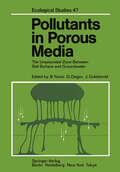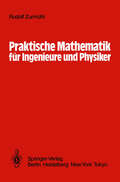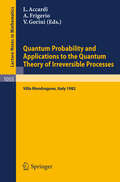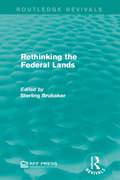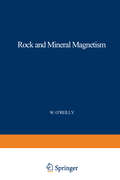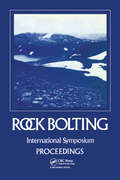- Table View
- List View
Phosphate Minerals
by J. O. Nriagu P. H. MooreThe literature on the geology, chemistry, and biochemistry of phosphorus generally takes its mineralogy for granted. The in cidental information on phosphate minerals given in these texts is often obsolescent and inaccurate. The few mineralogical texts that have dealt comprehensively with the phosphate minerals have now become outdated, and typically present the essential information in a manner unsuitable for nongeological readers. This volume is intended as a ready reference for workers who require good basic information on phosphate minerals or their synthetic equivalents. The topics covered should appeal to geologists and geochemists, lithologists, environmental scientists and engineers, chemists and biochemists who have any interest in the intricate world of phosphorus. The hard tissues of many vertebrates and the many pathological calcifications consist mostly of phosphate minerals. The precipita tion of these compounds also plays a major role in the ecological cycling of phosphorus, and occasionally even dominates the behavior of many trace metals in many geochemical and biolog ical systems. Indeed, many pegmatitic phosphate minerals have acquired some notoriety because of the rarer trace metals which they tend to accumulate. With the commercialization of phosphate fertilizers since the early part of the 19th century, phosphate minerals have assumed an important role in industrial chemistry and agriculture. Clearly, the study of phosphate minerals is important from the economic, agricultural, environmental and (human and animal) health viewpoint.
Physical and Computational Aspects of Convective Heat Transfer
by T. Cebeci P. BradshawThis volume is concerned with the transport of thermal energy in flows of practical significance. The temperature distributions which result from convective heat transfer, in contrast to those associated with radiation heat transfer and conduction in solids, are related to velocity characteristics and we have included sufficient information of momentum transfer to make the book self-contained. This is readily achieved because of the close relation ship between the equations which represent conservation of momentum and energy: it is very desirable since convective heat transfer involves flows with large temperature differences, where the equations are coupled through an equation of state, as well as flows with small temperature differences where the energy equation is dependent on the momentum equation but the momentum equation is assumed independent of the energy equation. The equations which represent the conservation of scalar properties, including thermal energy, species concentration and particle number density can be identical in form and solutions obtained in terms of one dependent variable can represent those of another. Thus, although the discussion and arguments of this book are expressed in terms of heat transfer, they are relevant to problems of mass and particle transport. Care is required, however, in making use of these analogies since, for example, identical boundary conditions are not usually achieved in practice and mass transfer can involve more than one dependent variable.
Physico-Chemical Behaviour of Atmospheric Pollutants: Proceedings of the Third European Symposium held in Varese, Italy, 10–12 April 1984
by B. Versino G. AngelettiProceedings of the Third European Symposium held in Varese, Italy, 10-12 April, 1984
Physik. Eine Einführung in Experiment und Theorie: Band 1: Mechanik (Hochschultext)
by Siegmund Brandt Hans D. DahmenPlanning for Agricultural Development (Routledge Library Editions: Agribusiness and Land Use #18)
by J. A. MollettOriginally published in 1984, this text was written as a guide to agricultural policy makers, planners and project managers in developing countries, particularly for those in the areas of programme formulation and implementation. Elements from successful agricultural and rural development plans have been selected. The work discusses the link between agricultural and overall planning, the various aspects of agricultural planning (including the usual components and deficiencies of plans, time horizons and scope of plans, and regional planning), and it concludes with brief look at the preparation of a plan and objectives for agricultural development.
Planning for Agricultural Development (Routledge Library Editions: Agribusiness and Land Use #18)
by J. A. MollettOriginally published in 1984, this text was written as a guide to agricultural policy makers, planners and project managers in developing countries, particularly for those in the areas of programme formulation and implementation. Elements from successful agricultural and rural development plans have been selected. The work discusses the link between agricultural and overall planning, the various aspects of agricultural planning (including the usual components and deficiencies of plans, time horizons and scope of plans, and regional planning), and it concludes with brief look at the preparation of a plan and objectives for agricultural development.
The Polarization Method of Seismic Exploration (Solid Earth Sciences Library #1)
by E.I. Galperinvariegated seismological conditions has been accumulated. The method has been developed further in two main directions: - the perfection of the techniques and equipment of three-component field studies incorporating a continuous control of the identity of equipment both in deep boreholes and on the surface; - the creation of efficient and straightforward software for the automatic processing of PM data. Whereas the early stages of development of the method have been conspicuous chiefly by the use of polarization for the discrimination of the wave field, in recent years the emphasis shifts to the use of polarization parameters to obtain additional information about the Earth. This is especially important, as the polarization parameters are very sensitive to inhomogeneities in cross-section and enable those parameters of the Earth to be studies which cannot be obtained from kinematics. Here one should especially mention the polarization of transverse waves, which can act as one of the most reliable parameters for identifying and studying anisotropic properties of the Earth. At present various modifications of PM are being developed applicable both to uphole - (PM RW = reflected waves method, PM CDP = common-depth-point method, PM refracted-wave method, PM of regional studies utilizing earthquakes) and to downhole observations (PM VSP = vertical seismic profiling). Not all the PM modifications are developing at the same rate. The method which has up to now been developed most extenSively is PM VSP.
Pollutants in Porous Media: The Unsaturated Zone Between Soil Surface and Groundwater (Ecological Studies #47)
by B. Yaron G. Dagan J. GoldshmidThe unsaturated zone is the medium through which pollutants move from the soil surface to groundwater. Polluting substances are subjected to complex physical, chemical and biological transformations while moving through the unsaturated zone and their displacement depends on the transport properties of the water-air porous medium system. Pollution caused by human activities, agriculture, and industry, has brought about a growing interest in the role of the unsaturated zone in groundwater pollution. Due to the complexity and the multidisciplinary nature of the subject, it is being investigated by specialists from various scientific disciplines, such as soil physicists, chemists, biologists, and environmental engineers. This state of affairs has motivated the initiative taken by the Water Quality Commissions of IUPAC (the International Union of Pure and Applied Chemistry) and IAHS (the International Association of Hydrological Sciences) to convene an international workshop, which was organized and hosted by the Institute of Soils and Water of the Agricultural Research Organization in Bet Dagan, Israel in March 1983. The lecturers at the workshop were an invited group of specialists who are engaged in studying the many facets of the unsaturated zone, and the present book is a selection of their presentations. Each chapter of the book relates to a different aspect of the unsaturated zone.
Principles of Sedimentary Basin Analysis
by Andrew MiallThis book is intended as a practical handbook for those engaged in the task of analyzing the paleogeographic evolution of ancient sedimentary basins. The science of stratigraphy and sedimentology is central to such endeavors, but although several excellent textbooks on sedimentology have appeared in recent years little has been written about modern stratigraphic methods. Sedimentology textbooks tend to take a theoretical approach, building from physical and chemical theory and studies of mod ern environments. It is commonly difficult to apply this information to practical problems in ancient rocks, and very little guidance is given on methods of observation, mapping and interpretation. In this book theory is downplayed and the emphasis is on what a geologist can actually see in outcrops, well records, and cores, and what can be ob tained using geophysical techniques. A new approach is taken to stratigraphy, which attempts to explain the genesis of lithostratigraphic units and to de-emphasize the importance of formal description and nam ing. There are also sections explaining principles of facies analysis, basin mapping methods, depositional systems, and the study of basin thermal history, so important to the genesis of fuels and minerals. Lastly, an at tempt is made to tie everything together by considering basins in the con text of plate tectonics and eustatic sea level changes.
Problems and Prospects in Long and Medium Range Weather Forecasting (Topics in Atmospheric and Oceanic Sciences)
by D. M. Burridge E. KällenForecasting the weather for the long and medium range is a difficult and scientifically challenging problem. Since the first operational weather prediction by numerical methods was carried out (on the BESK computer in Stockholm, Sweden, 1954) . there has been an ever accelerating development in computer technology. Hand in hand has followed a tremendous increase in the complexity of the atmospheric models used for weather prediction. The ability of these models to predict future states of the atmosphere has also increased rapidly, both due to model development and due to more accurate and plentiful observations of the atmosphere to define the initial . state for model integrations. It may however be argued on theoretical grounds that even if we have an almost perfect model with almost perfect initial data, we will never be able to make an accurate weather prediction more than a few weeks ahead. This is due to the inherent instability of the atmosphere and work in this field was pioneered by E. Lorenz. It is generally referred to as atmospheric predict ability and in the opening chapter of this book Professor Lorenz gives us an overview of the problem of atmospheric predictability. The contributions to this book were originally presented at the 1981 ECMWF Seminar (ECMWF - European Centre for Medium Range Weather Forecasts) which was held at ECMWF in Reading, England, in September 1981.
Progress in Gauge Field Theory (Nato Science Series B: #115)
by G. 'T Hooft A. Jaffe G. Lehmann P. K. Mitter I. M. SingerThe importance of gauge theory for elementary particle physics is by now firmly established. Recent experiments have yielded convincing evidence for the existence of intermediate bosons, the carriers of the electroweak gauge force, as well as for the presence of gluons, the carriers of the strong gauge force, in hadronic interactions. For the gauge theory of strong interactions, however, a number of important theoretical problems remain to be definitely resolved. They include the quark confinement problem, the quantitative study of the hadron mass spectrum as well as the role of topology in quantum gauge field theory. These problems require for their solution the development and application of non-perturbative methods in quantum gauge field theory. These problems, and their non-perturbative analysis, formed the central interest of the 1983 Cargese summer institute on "Progress in Gauge Field Theory. " In this sense it was a natural sequel to the 1919 Cargese summer institute on "Recent Developments in Gauge Theories. " Lattice gauge theory provides a systematic framework for the investigation of non-perturbative quantum effects. Accordingly, a large number of lectures dealt with lattice gauge theory. Following a systematic introduction to the subject, the renormalization group method was developed both as a rigorous tool for fundamental questions, and in the block-spin formulation, the computations by Monte Carlo programs. A detailed analysis was presented of the problems encountered in computer simulations. Results obtained by this method on the mass spectrum were reviewed.
Pyroclastic Rocks
by Richard V. Fisher Hans-Ulrich SchminckePyroclastic Rocks is the first modern comprehensive treatment of what they are and how they were formed. The subject is discussed against a background of plate tectonics theory and modern advances in volcanology, sedimentology and igneous petrology. The book provides a thorough discussion of magmatic volatiles and pyroclastic processes as well as magma-water interactions. Most of the book is concerned with the wide spectrum of pyroclastic rocks formed on land and under water and by fallout and various flowage mechanisms. Diagenetic processes by which pyroclastic particles are transformed into rocks are discussed in detail. The stratigraphic and tectonic importance of pyroclastic rocks are illustrated using selected case histories. This uniquely integrated account of pyroclastic processes, particles and rocks will prove a valuable aid in reconstructing dynamic aspects of earth evolution as well as predicting future volcanic hazards; understanding sedimentary basins containing petroleum and gas deposits; locating ore deposits in volcanic complexes and heat sources in geothermal prospecting; and facilitating stratigraphic analysis in complex volcanic terrains.
Quantum Gravity
by M. MarkovThree years have passed after the First Moscow Seminar on Quantum Gravity. It is a rather long time interval for the modern theoretical physics. The talks given at the present Second Seminar which took place in October 13-15, 1981 in Moscow contain the discussion of new results obtained during this period and the problems which arose. More than one hundred Soviet scientists and a number of the foreign guests attended this Seminar, which as the previous one was held by the Nuclear Physics Department of the Academy of Sciences of the USSR and the Institute for Nuclear Research of the Academy of Sciences of the USSR. The aim of the Seminar was to discuss the most important problems of the modern Quantum Gravity, namely: i) Quantum Gravity: the state of art; ii) Quantum effects in Cosmology; iii) Quantum black-hole physics; iv) the recent development in Supergravity and v) Quantum Gauge Theories. The Editorial Board expresses its sincere gratitude to all physicists who have contributed to these Proceedings for their cooperation with the Board in respect of time limitation, accurate and patient fulfilment of all tiresome requirements, set by the Board. The talks in the Proceedings are arranged in sections in accordance with their presentation at the Seminar.
Quantum Probability and Applications to the Quantum Theory of Irreversible Processes: Proceedings of the International Workshop held at Villa Mondragone, Italy, September 6-11, 1982 (Lecture Notes in Mathematics #1055)
by L. Accardi A. Frigerio V. GoriniQuaternary of South America and Antarctic Peninsula
by Jorge RabassaThis book focuses on the problems of the Quaternary in South America and Antarctic Peninsula, with a strong emphasis in the paleoenvironmental and paleoclimatic approach. It is based on contributions presented at the South American Regional Meeting held in Neuquen, Argentina.
Quaternary of South America and Antarctic Peninsula
by Jorge RabassaThis book focuses on the problems of the Quaternary in South America and Antarctic Peninsula, with a strong emphasis in the paleoenvironmental and paleoclimatic approach. It is based on contributions presented at the South American Regional Meeting held in Neuquen, Argentina.
Radiation in a Cloudy Atmosphere (Atmospheric and Oceanographic Sciences Library #6)
by E. M. FeigelsonRadiative heat transfer is a fundamental factor in the energetics of the terrestrial atmosphere: the system consisting of the atmosphere and the underlying layer is heated by the Sun, and this heating is compensated, on the average, by thermal radia tion. Only over a period of 1-3 days from some specified initial moment can the dynamic processes in the atmosphere be considered to be adiabatic. Global dynamic processes of long duration are regulated by the actual influxes of heat, one of the main ones being the radiative influx. Radiation must be taken into account in long-term, weather forecasting and when considering the global circulation of the atmosphere, the theory of climate, etc. Thus it is necessary to know the albedo of the system, the amount of solar radiation transmitted by the atmosphere, the absorptivity of the atmosphere vis-a-vis solar radiation, and also the effective radiation flux, the divergence of which represents the radiative cooling or heating. All these quantities have to be integrated over the wavelength spectrum of the solar or thermal radiation, and they must be ascertained as functions of the determining factors. The relation ships between the indicated radiation characteristics, the optical quantities directly determining them, the optically active compo nents of the atmosphere, and the meteorological fields will be discussed in this book.
Rational Thermodynamics
by C. TruesdellIn the first edition of this book I tried to survey in brief compass the main ideas, methods, and discoveries of rational thermodynamics as it then stood, only five years after Messrs. COLEMAN & NOLL, while in Baltimore, had written the fundamental memoir that provided for the new science the one root theretofore wanting. A survey in the same style today would require an almost wholly new book, three or four times as long. As it was in 1968, again in 1983 a consecutive treatise restricted to the foundations would be premature, for at this moment they are under earnest discussion, probing analysis, and powerful attack by several students and from several directions. Because, although in the first edition I expressed some opinions I no longer hold and made some statements I should now recast or even re tract, it seems even yet to offer a simple introduction to some aspects of the field that remain current, I have chosen to reprint it unaltered except for emendation of slips and bettering of the English here and there.
Rethinking the Federal Lands (Routledge Revivals)
by Sterling BrubakerThe federal government is by far the largest landowner in the United States. It is somewhat of an anomaly for the federal government to hold vast acreages of land in an economy where the prevailing ideology favours private ownership. The Reagan administration’s (1981-1989) proposal to increase energy and mineral development on federal lands, to accelerate timber harvesting in national forests, and to expand the sale of federal lands generated strong and vocal opposition. Originally published in 1984, in the midst of the Reagan era, Rethinking the Federal Lands examines why the U.S. has retained federal lands and questions how ownership affects the management of federal lands and the total benefits society derives from them. This title is ideal for students interested in environmental studies and policy making.
Rethinking the Federal Lands (Routledge Revivals)
by Sterling BrubakerThe federal government is by far the largest landowner in the United States. It is somewhat of an anomaly for the federal government to hold vast acreages of land in an economy where the prevailing ideology favours private ownership. The Reagan administration’s (1981-1989) proposal to increase energy and mineral development on federal lands, to accelerate timber harvesting in national forests, and to expand the sale of federal lands generated strong and vocal opposition. Originally published in 1984, in the midst of the Reagan era, Rethinking the Federal Lands examines why the U.S. has retained federal lands and questions how ownership affects the management of federal lands and the total benefits society derives from them. This title is ideal for students interested in environmental studies and policy making.
Rock and Mineral Magnetism
by W. O'ReillyThe past two decades have witnessed a revolution in the earth sciences. The quantitative, instrument-based measurements and physical models of. geophysics, together with advances in technology, have radically transformed the way in which the Earth, and especially its crust, is described. The study of the magnetism of the rocks of the Earth's crust has played a major part in this transformation. Rocks, or more specifically their constituent magnetic minerals, can be regarded as a measuring instrument provided by nature, which can be employed in the service of the earth sciences. Thus magnetic minerals are a recording magnetometer; a goniometer or protractor, recording the directions of flows, fields and forces; a clock; a recording thermometer; a position recorder; astrain gauge; an instrument for geo logical surveying; a tracer in climatology and hydrology; a tool in petrology. No instrument is linear, or free from noise and systematic errors, and the performance of nature's instrument must be assessed and certified. This has been the task of the research worker in rock and mineral magnetism.
Rock bolting: Proceedings of the international symposium, Abisko, Sweden, 28 August-2 September 1983
by Ove StephanssonThis includes the Proceedings of the international symposium, Abisko, Sweden, 28 August-2 September 1983. Rock bolts today represent the dominant support system in mines and underground structures. Some results and experiences are discussed to give a better understanding of the strength of individual rock bolts and systems of bolts, and the interaction between bolts and rock masses of various types. Topics covered are as follows: rock bolting in theory and experiments; design principles and experience; and ground control and instrumentation: cable bolting.
Rock bolting: Proceedings of the international symposium, Abisko, Sweden, 28 August-2 September 1983
by Ove StephanssonThis includes the Proceedings of the international symposium, Abisko, Sweden, 28 August-2 September 1983. Rock bolts today represent the dominant support system in mines and underground structures. Some results and experiences are discussed to give a better understanding of the strength of individual rock bolts and systems of bolts, and the interaction between bolts and rock masses of various types. Topics covered are as follows: rock bolting in theory and experiments; design principles and experience; and ground control and instrumentation: cable bolting.






